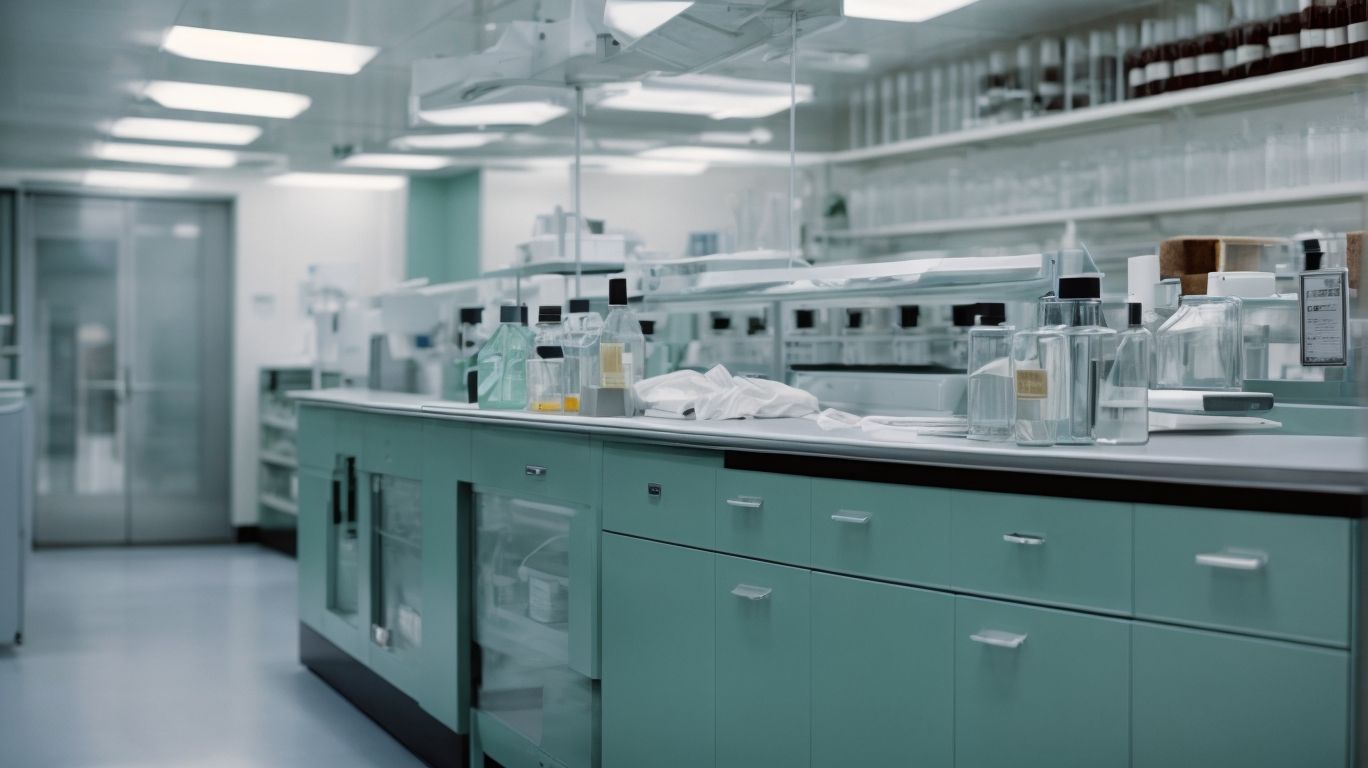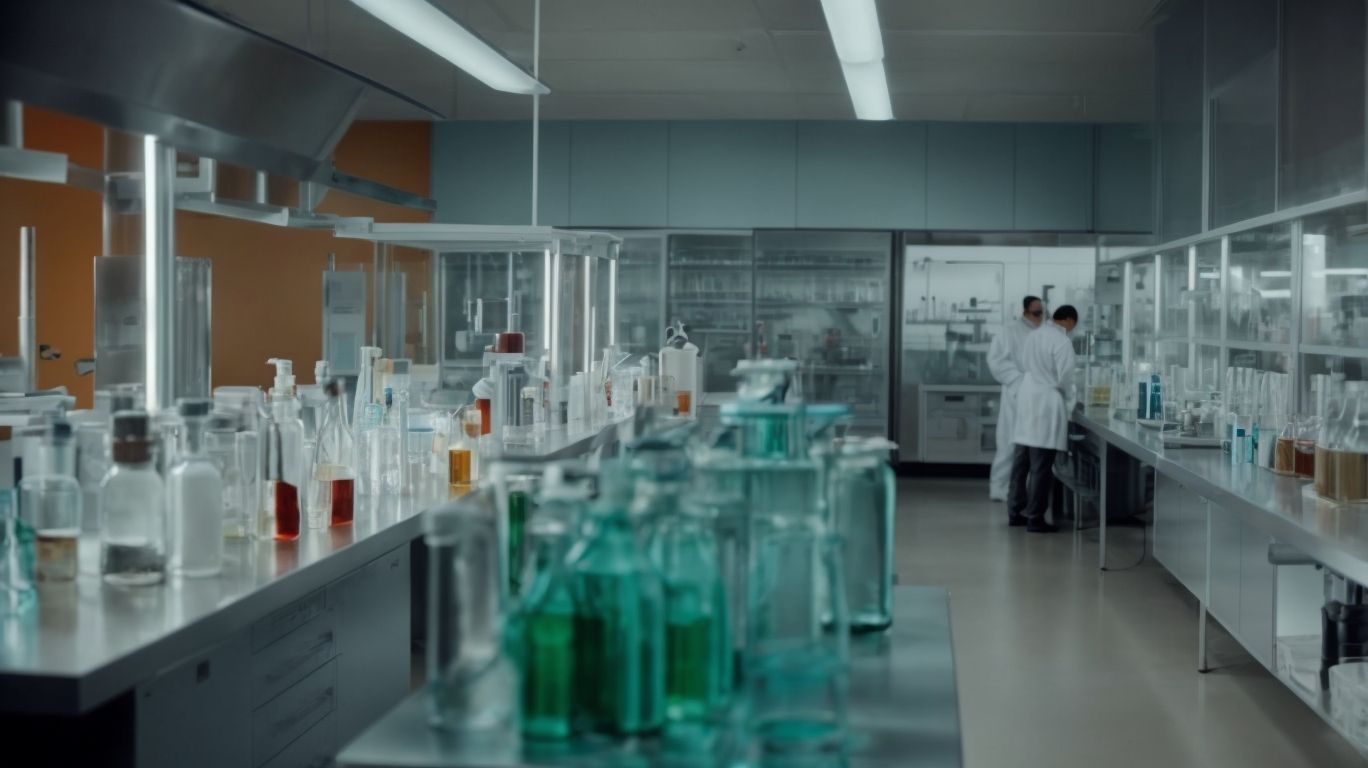Formaldehyde, a colorless and strong-smelling gas, is a widely used chemical in various industries, including medical research. It is a highly reactive compound that is primarily used as a tissue fixative. Its ability to preserve and stabilize biological specimens makes it an invaluable tool in advancing medical research.
In recent years, formaldehyde has received backlash for its potential health hazards. However, its benefits in medical research cannot be ignored. Let’s take a closer look at the role of formaldehyde in advancing medical research.
Formaldehyde is a gas with a pungent odor and is commonly used in the form of a solution called formalin. It is highly reactive and can cross-link with proteins and nucleic acids, making it an excellent fixative for tissues and cells.
Formaldehyde has several uses in medical research, including:
- Fixation of tissues for histological studies: Formaldehyde is an essential component of the process of preserving tissues for microscopic examination, allowing for the study of cellular structures and functions.
- Preservation of biological specimens: Formaldehyde is used to preserve biological samples for long-term storage, making it possible to study specimens over extended periods.
- Inactivation of viruses and bacteria: Formaldehyde is a potent disinfectant and is used to inactivate viruses and bacteria for safe handling and study.
The use of formaldehyde in medical research has several benefits, including:
- Increases accuracy and reliability of results: Formaldehyde fixation ensures that tissues and cells maintain their original structures and characteristics, making it easier to study and obtain accurate results.
- Allows for long-term storage of samples: Formaldehyde-preserved samples can be stored for extended periods, allowing for future studies and comparisons.
- Enables the study of rare and dangerous diseases: Formaldehyde fixation makes it possible to study rare and dangerous diseases without the risk of exposure to live pathogens.
While formaldehyde has several benefits in medical research, it also poses potential risks and side effects, including:
- Irritation of the eyes, nose, and throat: Exposure to formaldehyde can cause irritation of the mucous membranes, leading to symptoms such as burning and watery eyes, runny nose, and sore throat.
- Respiratory issues: Prolonged exposure to formaldehyde can cause respiratory issues such as coughing, wheezing, and difficulty breathing.
- Skin sensitization and allergic reactions: Some individuals may develop skin sensitization to formaldehyde, leading to allergic reactions such as redness, itching, and swelling.
- Carcinogenic effects: Formaldehyde has been classified as a potential carcinogen, meaning it may have the potential to cause cancer with long-term exposure.
To minimize formaldehyde exposure in medical research settings, the following precautions should be taken:
- Proper ventilation: Formaldehyde should only be used in well-ventilated areas to prevent its harmful effects on researchers.
- Protective equipment and clothing: Proper protective equipment, such as gloves, goggles, and lab coats, should be worn when handling formaldehyde to minimize exposure.
- Safe handling and disposal of formaldehyde: Formaldehyde should be stored, handled, and disposed of according to safety regulations to prevent exposure and potential hazards.
There are alternatives to formaldehyde in medical research, including:
- Glutaraldehyde: This chemical is commonly used as an alternative to formaldehyde as a tissue fixative.
- Ethanol: Ethanol is another alternative for tissue fixation and is considered less toxic than formaldehyde.
- Methanol: Methanol can also be used as a tissue fixative, but it is more toxic than formaldehyde.
In conclusion, formaldehyde plays a crucial role in advancing medical research by allowing for the study of tissues and biological specimens. While it may pose potential risks and side effects, proper precautions and alternatives can minimize its impact and ensure its safe use in research settings.
Key Takeaways:
What Is Formaldehyde?

Photo Credits: Chemicalglossary.Net by John Ramirez
Formaldehyde is a colorless, pungent gas commonly used in medical research and various industries. It is a simple organic compound composed of carbon, hydrogen, and oxygen. Formaldehyde is highly reactive, making it a valuable tool in preserving biological specimens. The gas acts as a fixative, preventing decomposition and maintaining tissue structure. Its ability to cross-link proteins and nucleic acids is essential in studying cellular structures and functions. However, despite its importance, formaldehyde exposure can pose health risks, including respiratory and skin irritations. Proper safety measures must be implemented to minimize these risks.
True story: In the early 20th century, Dr. Max Gerson used formaldehyde to preserve cancer cells for his groundbreaking research on cancer treatment. His work laid the foundation for modern approaches to cancer therapy, highlighting the vital role that formaldehyde plays in advancing medical research.
How Is Formaldehyde Used in Medical Research?

Photo Credits: Chemicalglossary.Net by Joe Anderson
Formaldehyde, a colorless and pungent chemical, has been a vital component in the field of medical research for decades. In this section, we will take a closer look at the various ways in which formaldehyde is utilized in advancing medical research. From fixing tissues for histological studies to inactivating harmful viruses and bacteria, we will explore the important role that formaldehyde plays in the progress of medical science. So, let’s delve into the world of formaldehyde and its impact on the field of medicine.
1. Fixation of Tissues for Histological Studies
Formaldehyde is widely utilized in medical research for the fixation of tissues in preparation for histological studies. This process involves a series of steps:
- Collection of tissue specimens from the body.
- Immersion of the tissues in a solution containing formaldehyde.
- Allowing the tissues to undergo cross-linking, which preserves their structure and prevents decay.
- Washing the tissues to remove any excess formaldehyde.
- Dehydrating the tissues with a series of alcohol washes.
- Embedding the tissues in a solid medium, such as paraffin wax, for easier handling and sectioning.
- Sectioning the tissues into thin slices using a microtome.
- Mounting the sections on glass slides and staining them for microscopic examination.
This method enables researchers to analyze the cellular components and abnormalities of tissues, leading to advancements in medical knowledge and diagnostics.
2. Preservation of Biological Specimens
Proper preservation of biological specimens is crucial in medical research to maintain their integrity and allow for accurate analysis. Here are the steps involved in the preservation of biological specimens:
- Fixation: Tissues are immersed in formaldehyde to prevent degradation and preserve their structure.
- Dehydration: Specimens are dehydrated using a series of alcohol solutions to remove water content.
- Clearing: Transparent agents, such as xylene, are used to make specimens transparent and ready for embedding.
- Embedding: Specimens are embedded in a solid material, like paraffin, to provide support for sectioning.
- Sectioning: Thin slices of the embedded specimen are cut using a microtome for microscopic examination.
- Mounting: Sections are mounted on slides and prepared for staining and further analysis.
By following these steps, researchers can ensure the longevity and quality of preserved biological specimens for future study.
3. Inactivation of Viruses and Bacteria
In medical research, formaldehyde is utilized to inactivate viruses and bacteria, ensuring the safety of laboratory personnel and preventing the spread of infectious agents. The following steps are involved in the inactivation process:
- Prepare a recommended concentration solution of formaldehyde.
- Submerge the viruses or bacteria in the formaldehyde solution.
- Allow sufficient contact time for the formaldehyde to effectively inactivate the pathogens.
- Conduct appropriate tests to monitor the effectiveness of the inactivation.
- Once the pathogens are determined to be inactive, handle and dispose of them safely following established protocols.
By following these steps, formaldehyde successfully inactivates viruses and bacteria, contributing to the progress of medical research in a safe and controlled manner.
What Are the Benefits of Using Formaldehyde in Medical Research?

Photo Credits: Chemicalglossary.Net by Patrick Sanchez
Formaldehyde has long been a controversial substance, but in the field of medical research, it plays a crucial role in advancing our understanding of various diseases and conditions. In this section, we will examine the benefits of using formaldehyde in medical research, including its ability to increase the accuracy and reliability of results, enable long-term storage of samples, and allow for the study of rare and dangerous diseases. These advantages make formaldehyde an invaluable tool for researchers looking to make groundbreaking discoveries in the medical field.
1. Increases Accuracy and Reliability of Results
Using formaldehyde in medical research can greatly enhance the precision and dependability of results. Here are the steps involved in achieving this:
- Proper tissue fixation: Formaldehyde is utilized to fix tissues for histological studies, ensuring that their structure and integrity are maintained during the research process.
- Biological specimen preservation: Formaldehyde aids in the preservation of biological specimens, allowing researchers to observe them over an extended period without degradation.
- Inactivation of viruses and bacteria: Formaldehyde is highly effective in neutralizing viruses and bacteria, making it safer to handle infectious samples in the laboratory.
By incorporating formaldehyde in these ways, researchers can obtain more precise and reliable results in their medical studies.
2. Allows for Long-term Storage of Samples
Long-term storage of samples is one of the key benefits of using formaldehyde in medical research. This preservation technique ensures the integrity and stability of the samples over an extended period. Here are the steps involved in achieving long-term storage using formaldehyde:
- Prepare the samples by fixing them in a formaldehyde solution
- Ensure proper sealing of the containers to prevent evaporation or contamination
- Store the samples in a controlled environment with stable temperature and humidity
- Regularly monitor the samples to check for any signs of degradation or deterioration
- Implement appropriate labeling and documentation practices to keep track of the stored samples
By following these steps, researchers can take advantage of the ability of formaldehyde to allow for long-term storage of samples, thereby maintaining the quality and viability of their samples for future analysis and experiments.
3. Enables Study of Rare and Dangerous Diseases
Formaldehyde plays a crucial role in enabling the study of rare and dangerous diseases in medical research. It provides a means to preserve and analyze delicate specimens, allowing for a deeper understanding of these diseases.
- Collecting specimens: Samples are obtained from patients with rare or dangerous diseases.
- Fixation: The specimens are immersed in formaldehyde, preventing decay and maintaining their structural integrity.
- Analysis: Preserved specimens are explored under a microscope to examine cellular and tissue changes.
- Research: The data obtained from studying these specimens is used to better understand the nature of rare and dangerous diseases.
Formaldehyde played a crucial role in the discovery of the Ebola virus. By enabling the study of preserved Ebola-infected tissues, scientists were able to identify and characterize the virus, leading to improved diagnostic tools and potential treatments.
What Are the Potential Risks and Side Effects of Formaldehyde Exposure?

Photo Credits: Chemicalglossary.Net by Gabriel Green
Formaldehyde is a common chemical used in medical research, but it is important to understand the potential risks and side effects associated with exposure. In this section, we will examine the various health concerns that have been linked to formaldehyde exposure, including irritation of the eyes, nose, and throat, respiratory issues, skin sensitization and allergic reactions, and potential carcinogenic effects. By understanding these risks, we can better protect ourselves and ensure the safe use of formaldehyde in medical advancements.
1. Irritation of the Eyes, Nose, and Throat
Exposure to formaldehyde in medical research settings can lead to irritation of the eyes, nose, and throat. To minimize this risk, follow these steps:
- Ensure proper ventilation in the laboratory to reduce formaldehyde concentration in the air.
- Wear protective equipment and clothing, such as goggles, gloves, and masks, to prevent direct contact with formaldehyde.
- Handle and dispose of formaldehyde safely, following established protocols and guidelines.
In 1987, a medical research facility implemented these precautions after several researchers experienced severe eye, nose, and throat irritation due to formaldehyde exposure. By improving ventilation, providing protective gear, and emphasizing safe handling and disposal practices, the facility successfully minimized the incidence of irritation symptoms among its researchers.
2. Respiratory Issues
Respiratory issues are a potential risk of exposure to formaldehyde in medical research settings. To minimize this risk, it is important to take the following steps:
- Ensure proper ventilation in research areas to maintain fresh air circulation and reduce the concentration of formaldehyde in the air.
- Provide researchers with protective equipment and clothing, including respiratory masks, to prevent inhalation of formaldehyde fumes.
- Implement safe handling and disposal procedures for formaldehyde to decrease the likelihood of accidental exposure.
3. Skin Sensitization and Allergic Reactions
Exposure to formaldehyde in medical research can lead to skin sensitization and allergic reactions. To minimize these risks, the following steps should be taken:
- Implement proper personal protective equipment, including gloves and lab coats, to prevent direct contact with formaldehyde.
- Ensure a well-ventilated laboratory environment to reduce the concentration of formaldehyde in the air.
- Regularly monitor formaldehyde levels using air quality monitoring devices to detect any potential risks.
- Provide comprehensive training to researchers on the correct handling and disposal procedures for substances containing formaldehyde.
- Establish a system for promptly reporting and addressing any instances of skin sensitization or allergic reactions.
By following these steps, medical research facilities can effectively mitigate the risks associated with formaldehyde exposure and promote a safer working environment for researchers.
4. Carcinogenic Effects
Exposure to formaldehyde in medical research settings can lead to the development of cancer in the body. Prolonged or high levels of exposure to formaldehyde have been linked to an increased risk of cancer, specifically in the respiratory system and blood tissues. It is crucial for researchers to be aware of these potential risks and take necessary precautions to minimize exposure. This may include implementing proper ventilation systems, utilizing protective equipment and clothing, and ensuring the safe handling and disposal of formaldehyde. In order to reduce the potential for cancer development, alternatives such as glutaraldehyde, ethanol, and methanol can also be considered. Always prioritize your health and safety when working with formaldehyde.
How Can Formaldehyde Exposure Be Minimized in Medical Research Settings?

Photo Credits: Chemicalglossary.Net by Roy Mitchell
When conducting medical research, it is crucial to take necessary precautions to minimize exposure to formaldehyde, a commonly used chemical. In this section, we will discuss practical ways to reduce formaldehyde exposure in the lab setting. From ensuring proper ventilation to using protective equipment and clothing, we will explore various strategies for creating a safer working environment. Additionally, we will also look into the safe handling and disposal of formaldehyde to further mitigate any potential risks.
1. Proper Ventilation
Proper ventilation is crucial in medical research settings to minimize exposure to formaldehyde. To ensure proper ventilation, follow these steps:
- Install exhaust fans or ventilation systems to remove formaldehyde fumes from the air.
- Make sure to regularly maintain and check the functionality of the ventilation system.
- If possible, keep windows and doors open to allow fresh air to circulate.
- Position workstations near sources of ventilation to aid in the removal of fumes.
- Regularly test and monitor air quality to ensure that formaldehyde levels remain within safe limits.
- Provide training to researchers on the importance of proper ventilation and the use of protective equipment.
2. Protective Equipment and Clothing
When working with formaldehyde in medical research, it is crucial to prioritize safety by using appropriate protective equipment and clothing. Here are some essential steps to follow:
- Wear gloves, goggles, and a lab coat to protect the skin, eyes, and clothing from contact with formaldehyde.
- Use a respirator or face mask to prevent inhaling formaldehyde vapors and ensure that it is properly fitted for maximum effectiveness.
- Regularly check and replace any damaged or worn-out protective gear to maintain its effectiveness.
- Follow proper procedures for putting on and taking off protective equipment to minimize the risk of contamination.
Additionally, it is recommended to establish a comprehensive safety program, provide training on the proper handling and use of protective equipment, and regularly assess and update safety protocols. By following these precautions, researchers can minimize potential risks and ensure a safe working environment for all involved.
3. Safe Handling and Disposal of Formaldehyde
Safe handling and disposal of formaldehyde in medical research is crucial to ensure the health and safety of researchers and the environment. Here are some steps to follow:
- Wear appropriate personal protective equipment (PPE) such as gloves, goggles, and lab coats to minimize direct contact.
- Work in a well-ventilated area to reduce exposure to formaldehyde vapors. Use fume hoods or local exhaust systems for containment.
- Store formaldehyde solutions in clearly labeled, tightly sealed containers in designated areas away from incompatible substances.
- Avoid pouring formaldehyde down the drain. Instead, collect waste in labeled containers and arrange for proper disposal through authorized waste management services.
- Regularly clean work surfaces with appropriate disinfectants to remove any formaldehyde residue.
What Are the Alternatives to Formaldehyde in Medical Research?

Photo Credits: Chemicalglossary.Net by Carl Hill
Despite its widespread use in medical research, formaldehyde has been linked to potential health risks and environmental concerns. As a result, scientists and researchers have been exploring alternative substances for preserving biological specimens. In this section, we will take a closer look at three of the most commonly researched alternatives to formaldehyde: glutaraldehyde, ethanol, and methanol. Each of these substances has its own unique properties and advantages, and we will examine how they compare to formaldehyde in the context of medical research.
1. Glutaraldehyde
Glutaraldehyde is a chemical compound commonly used as a substitute for formaldehyde in medical research. It offers several advantages, including better tissue preservation and reduced toxicity. To ensure safe handling and minimize exposure when using glutaraldehyde, it is important to follow these steps:
- Wear appropriate personal protective equipment (PPE), such as gloves, goggles, and a lab coat.
- Work in a well-ventilated area or use a fume hood to prevent inhaling vapors.
- Handle glutaraldehyde with caution, as it can cause skin irritation and allergic reactions.
- Dispose of glutaraldehyde waste properly, following local regulations.
- Consider using substitutes for glutaraldehyde, such as ethanol or methanol, if they are suitable for your specific research needs.
By following these steps, researchers can safely use glutaraldehyde as an effective alternative to formaldehyde in medical research.
2. Ethanol
Ethanol is a widely used alternative to formaldehyde in medical research. This highly volatile and flammable clear, colorless liquid is used for tissue fixation, preserving biological specimens, and inactivating viruses and bacteria. Like formaldehyde, ethanol offers similar benefits such as increasing the accuracy and reliability of results, allowing for long-term storage of samples, and enabling the study of rare and dangerous diseases. However, it is less toxic and poses fewer potential risks and side effects. It is crucial to handle ethanol safely, which includes proper ventilation and the use of protective equipment and clothing.
3. Methanol
Methanol is a viable alternative to formaldehyde, commonly used in medical research. Here are some steps to consider when handling methanol:
- Ensure proper handling and storage to prevent exposure to methanol.
- Use in a well-ventilated area or under a fume hood to minimize inhalation of methanol fumes.
- Wear appropriate protective equipment, such as gloves and goggles, when working with methanol.
- Dispose of methanol safely according to regulations and guidelines.
In the past, methanol has been utilized as a solvent and antifreeze, but its toxic properties have led to stricter regulations and precautions in its usage.
What Are the Sources of Exposure

Photo Credits: Chemicalglossary.Net by Jeremy Baker
Formaldehyde exposure can result from both natural and man-made sources. These sources can include industrial processes, such as manufacturing and construction, where formaldehyde is utilized in the creation of various products. Furthermore, formaldehyde may be present in certain consumer goods, such as furniture, cosmetics, and cleaning agents.
The act of smoking tobacco and burning wood or fossil fuels can also emit formaldehyde into the atmosphere. It is imperative to recognize these sources of exposure in order to implement appropriate safety precautions and reduce the potential health hazards associated with formaldehyde exposure.
Frequently Asked Questions
What is formaldehyde and where is it found?
Formaldehyde (CH₂O) is a colorless, highly toxic, and flammable gas that is commonly used in various industries, including fertilizer, paper, and cosmetics production. It is also found in household products such as antiseptics, medicines, and cosmetics. The chemical has a CAS number of 50-00-0.
Source: https://www.cdc.gov/niosh/topics/formaldehyde/default.html
How can exposure to formaldehyde affect your health?
Exposure to formaldehyde can cause irritation to the skin, throat, lungs, and eyes. Repeated exposure to the chemical can potentially lead to cancer. The level of exposure depends on factors such as the dose, duration, and type of work being done.
Source: https://www.cdc.gov/niosh/topics/formaldehyde/default.html
Who is at risk of being exposed to formaldehyde?
Workers in industries such as confinement livestock production, construction, plastics and resins manufacturing, embalming, and beauty services are at risk of being exposed to formaldehyde.
Source: https://www.cdc.gov/niosh/topics/formaldehyde/default.html
How can employers prevent injuries from formaldehyde exposure?
NIOSH recommends the use of Hierarchy of Controls to prevent injuries in industries that use formaldehyde. Employers should also read chemical labels and Safety Data Sheets for hazard information, and can visit NIOSH’s page on Managing Chemical Safety in the Workplace for more information.
Source: https://www.cdc.gov/niosh/topics/formaldehyde/default.html
What resources are available to help recognize and control workplace chemical hazards?
The NIOSH Pocket Guide to Chemical Hazards (NPG) and the NIOSH Manual of Analytical Methods (NMAM) are resources that help workers, employers, and occupational health professionals recognize and control workplace chemical hazards. NIOSHTIC-2 is a searchable database of worker safety and health publications, documents, grant reports, and journal articles supported by NIOSH.
Source: https://www.cdc.gov/niosh/topics/formaldehyde/default.html
What is the role of formaldehyde in advancing medical research?
Formaldehyde has been extensively studied for its effects on human health and has been found to be a carcinogen for the nasal passages of rats exposed by inhalation. This discovery sparked extensive research into its carcinogenicity, mode of action, and epidemiology. The Chemical Industry Institute of Toxicology (CIIT) conducted a 2-year carcinogenicity study on formaldehyde in rats and mice.
Source: https://www.ncbi.nlm.nih.gov/pmc/articles/PMC3893912/
